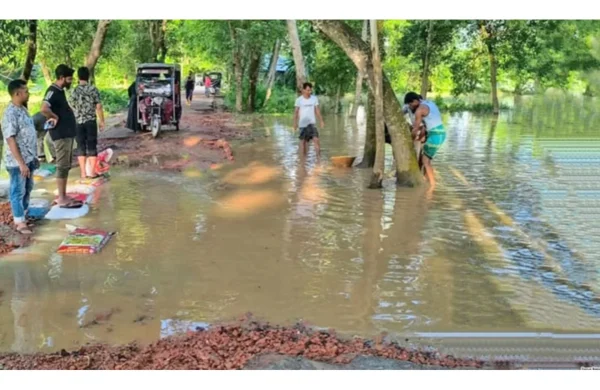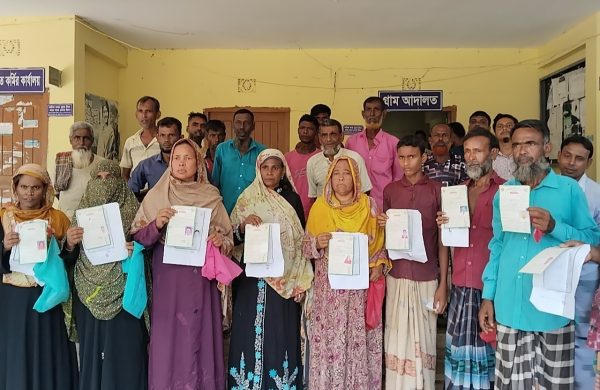Floodwater recedes, Tk43 lakh crop loss reported across 20 districts
- Update Time : Tuesday, July 15, 2025

Staff Correspondent:
As floodwaters recede following days of heavy rainfall and upstream water surges from India, the extent of agricultural losses in Bangladesh is becoming clearer. According to the Ministry of Agriculture, crops worth Tk4.3 million have been destroyed across 20 districts. Between July 4 and 14, around 41,788 hectares of land were flooded, with 18,340 hectares declared fully damaged. The losses have resulted in an estimated production shortfall of 95,490 tonnes. Crops affected include Aus paddy, Aman seedbeds, and a variety of vegetables such as green chilli, tomato, ginger, turmeric, and betel leaf.
The 20 districts impacted by the floods are Cumilla, Chandpur, Brahmanbaria, Cox’s Bazar, Noakhali, Feni, Lakshmipur, Rangamati, Khagrachhari, Pabna, Khulna, Bagerhat, Satkhira, Narail, Barisal, Jhalakathi, Patuakhali, Barguna, Bhola, and Shariatpur. The agriculture ministry’s assessment shows that Aus paddy alone has accounted for Tk18,972 lakh in losses across 9,189 hectares, while Aman seedbeds sustained damage worth Tk2,549 lakh across 2,209 hectares. Vegetable crops were the worst hit, with losses amounting to Tk20,258 lakh. Green chilli was damaged to the tune of Tk258 lakh, summer watermelon losses stood at Tk123 lakh, and ginger at Tk117 lakh.
In Feni district, the situation has been especially dire. Flash floods triggered by the overflowing Muhuri, Kahuya, and Silonia rivers breached embankments at 36 locations—19 in Parshuram and 17 in Fulgazi—submerging 137 villages. The Department of Agricultural Extension (DAE) estimates agricultural losses in Feni alone at Tk5,000 crore, with 5,564 hectares of cropland affected. Crops destroyed include Aus paddy, summer vegetables, chilli, turmeric, tomato, Aman seedbeds, and large areas of ginger cultivation.
The fisheries sector has also suffered substantial losses. According to the District Fisheries Office, approximately 2,330 ponds, lakes, and farms have been damaged, resulting in the loss of 276 tonnes of fish valued at Tk5.9 crore, and 128 tonnes of fish fry worth Tk3.5 lakh. Infrastructure damage in the fisheries sector is estimated at Tk42.5 lakh. The Department of Livestock Services reports the deaths of 10,600 chickens, 235 ducks, three goats, one sheep, and four cows. Additional losses include seven tonnes of poultry feed, 30 tonnes of straw, and 160 tonnes of grass, bringing the total loss in livestock to Tk64.89 lakh.
Noakhali has also seen widespread devastation, with Aman seedbeds and Aus paddy fields submerged across six upazilas, affecting 57 unions. The DAE reports that 5,199 hectares of crops were inundated. At least 24,950 families remain stranded, 58 homes have been destroyed, and more than 1,000 people have taken refuge in 27 relief centres. Medical teams—29 in total—are operating across affected areas to provide emergency care.
In Lakshmipur, around 200 families are stranded, and floodwaters have submerged 375 hectares of Aman seedbeds, 1,100 hectares of Aus paddy, and 95 hectares of vegetable fields. Roads in several areas, including those near graveyards, remain submerged, adding to residents’ difficulties.
Agricultural economist Dr Jahangir Alam told The Daily journalist still be mitigated if the government acts swiftly. “Timely support with seeds and inputs for replanting, particularly vegetables, could help farmers recover, as the season is still viable,” he said. He warned, however, that if recultivation efforts fall short, the already high vegetable prices could rise even further.
Speaking at the launch of new flood forecasting tools at the Bangladesh-China Friendship Conference Centre, Environment Adviser Syeda Rizwana Hasan emphasized the need for better early warning systems. She pointed out that India often gives Bangladesh only two hours’ notice before releasing upstream dam water—barely enough time to prepare. “Sometimes the alerts come at midnight, which makes it difficult or even impossible to respond in time,” she said. She called for investment in high-tech forecasting systems and a reduction in reliance on short-notice warnings from upstream countries.
Meanwhile, the Bangladesh Meteorological Department has warned of further heavy to very heavy rainfall in Dhaka, Khulna, and Barishal divisions due to a low-pressure system over the Bay of Bengal. In its latest bulletin, the department also predicted moderate to heavy rainfall in Rangpur, Rajshahi, Mymensingh, and Sylhet divisions, with gusty winds accompanying the showers. Significant air pressure differences over the North Bay may trigger squally weather. Maritime ports in Chattogram, Cox’s Bazar, Mongla, and Payra have been advised to hoist Local Cautionary Signal No. 3. Fishing boats and trawlers are urged to remain near the coast and proceed with caution until further notice.












